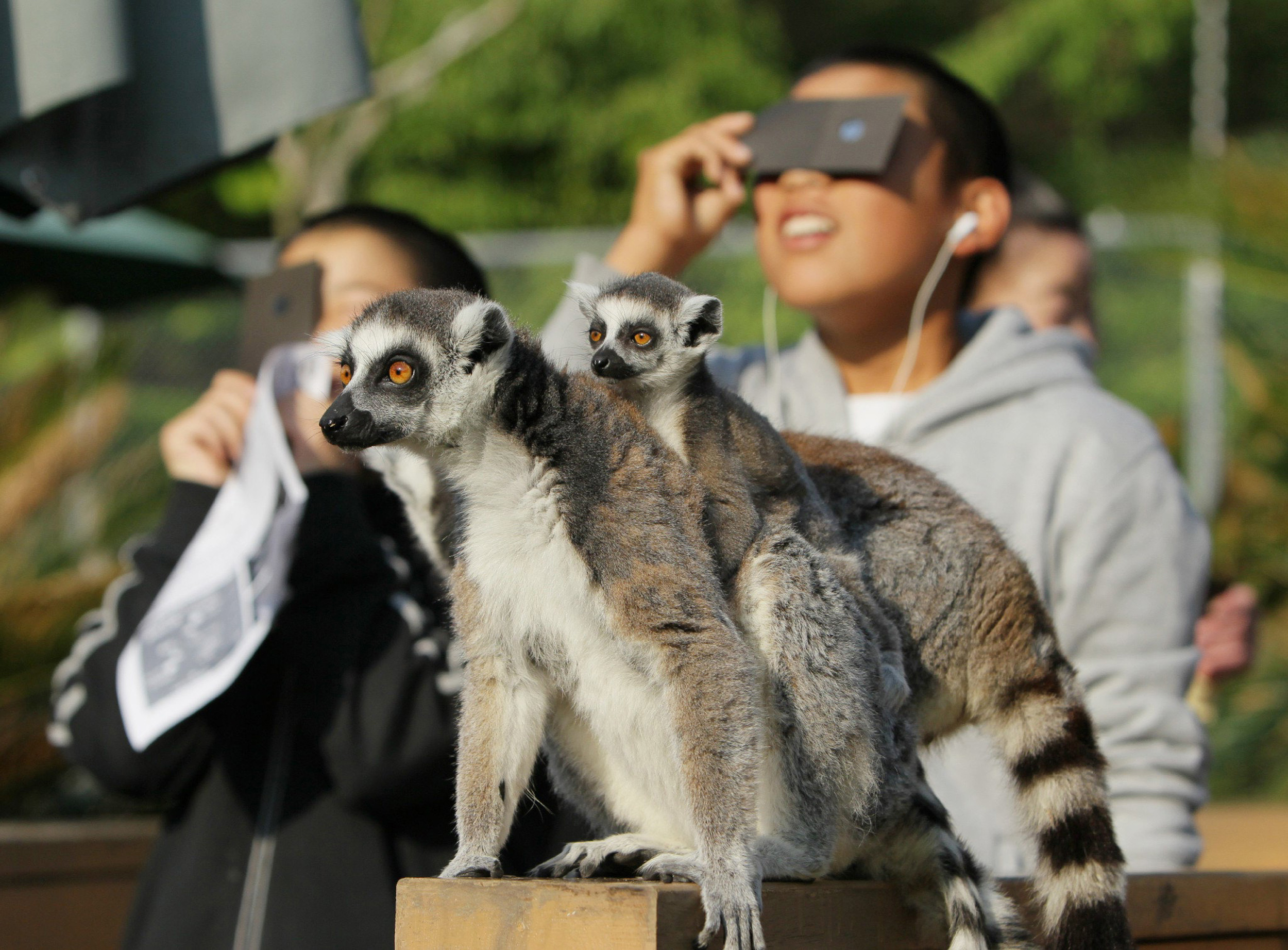
Howling at odd times, taking an early siesta or tearing down their webs — humans aren't the only creatures in North America who will be affected by the total solar eclipse on April 8, 2024.
For up to 4 minutes and 28 seconds on Monday, April 8, the moon will completely block out the sun along a 115-mile-wide (185 kilometers), 10,000-mile-long (16,000 km) band of Mexico, the United States and Canada called the path of totality. The skies will darken considerably for longer than that, in an even broader swath of North America, where a partial solar eclipse will be visible to tens of millions of observers.
The astronomical event may affect animals, whose circadian rhythms are tied to the planet's cycle of light and dark, Live Science previously reported.
Animals, like humans, could theoretically be blinded by looking directly at the sun during the solar eclipse. However, Fluffy and Pickles probably also have the common sense or instinct to not stare directly at the sun, meaning the risk of eye damage is probably pretty low, Live Science previously reported. (However, those who are extra cautious can certainly purchase a pair of eclipse glasses for their cat or dog if they so desire.)
Day and night
Much of animal behavior is strongly tied to the cycles of light and dark that govern our planet. For instance, many birds chirp more vigorously as they're bedding down in their nests for the night, and cicadas typically croon at dusk.
However, this ordinary day-night behavior may be disrupted during an eclipse. For instance, a 2009 Chinese report found that cicadas and birds dramatically altered their songs and behaviors in response to the total solar eclipse on July 22, 2009. Spiders have also reportedly torn down their webs during an eclipse.
Sign up for the Live Science daily newsletter now
Get the world’s most fascinating discoveries delivered straight to your inbox.
"It is clear that animals respond to the eclipse," National Park Service scientist Kurt Fristrup with the Natural Sounds and Night Skies Division, said in a statement. "The question is going to be: How much of that response is detectable acoustically? We could see dramatic changes. Past research has studied individual sites during an eclipse, and a few papers have been published, but no one has looked at this phenomenon on a continental scale."
And wild animals aren't the only ones likely to respond. Zoo animals and those in captivity may also be affected. For instance, a 1973 report found that captive ground squirrels get more antsy during a solar eclipse and move around more. Meanwhile, during the 1994 solar eclipse visible in Chile, hamadryas baboons in captivity got less active, perhaps because they were confused and thought it was nighttime, according to a 2003 study published in the journal Zoo Biology.

Chimpanzees, our closest living relatives, seem to also have the most human-like response. Jane Gooddall noted in her famous 1986 study of the animals "The Chimpanzees of Gombe: Patterns of Behavior," (Belknap Press, 1986) that they will climb high structures, orient their bodies toward the sun and point, yell and gesticulate toward the eclipse, as if to say "look at that!" Scientists at eight Japanese research institutions and zoos looked for abnormal behavior during an annular eclipse in 2013. They found strange behavior at four of those sites.
Of course, it's also possible that chimps in those institutions were picking up on the excitement of their human captors, the study noted. And a 2016 study found at least a few chimpanzees that seemed thoroughly uninterested in and unaffected by an annular solar eclipse in Tanzania, according to a report in Pan Africa News.
Protecting creatures' eyes
Most animal eyes operate in a very similar way to human eyes, with light-sensitive receptors in the eye that can be overloaded by the very focused light that comes with staring directly at the sun. For that reason, animals are just as likely to damage their eyes if they stare directly at the sun, or a partial solar eclipse.
However, unlike humans, animals might be less prone to stare right at the sun, Angela Speck, director of astronomy and a professor of astrophysics at the University of Missouri, said at a news conference with NASA on June 21, 2017, prior to the last total solar eclipse to cross the United States.
Others aren't so sure and are fitting their precious pups and kitties with eclipse glasses, just in case.
"Safe solar viewing is always a must, no matter who it is," Mike Reynolds, an astronomy professor at Florida State College in Jacksonville, Florida, said at the Northeast Astronomy Forum in April, 2017, Live Science previously reported.
After the eclipse has passed, those who want to study and share strange animal repsonses are invited to participate in NASA's citizen science project Eclipse Soundscapes. To help better understand how eclipses affect life on Earth, viewers may digitally submit observations and sound recordings of animal reactions to the April 8 solar eclipse to the Eclipse Soundscapes team. Visit the project's official website (linked above) for more information on how to get involved.
Update: This article was edited on March 7, 2024, to include information about the upcoming total solar eclipse on April 8. An older version of this article was written for the 2017 total solar eclipse over North America.

Tia is the managing editor and was previously a senior writer for Live Science. Her work has appeared in Scientific American, Wired.com and other outlets. She holds a master's degree in bioengineering from the University of Washington, a graduate certificate in science writing from UC Santa Cruz and a bachelor's degree in mechanical engineering from the University of Texas at Austin. Tia was part of a team at the Milwaukee Journal Sentinel that published the Empty Cradles series on preterm births, which won multiple awards, including the 2012 Casey Medal for Meritorious Journalism.










